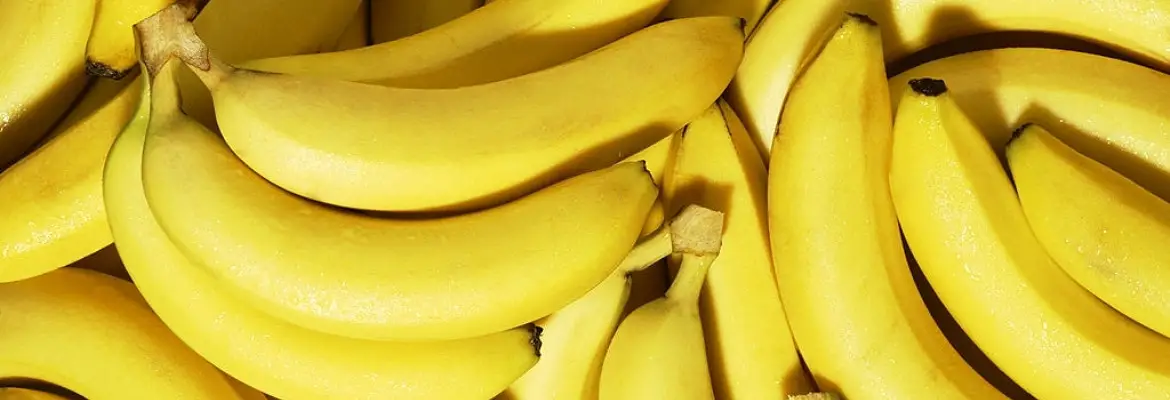Banana, arguably, if not the most, is one of the most famous and widespread fruit in the world. An interesting fact is banana tree is not a tree but rather the largest herb in the world.
Ripe bananas have a thick yellow skin which when peeled revels a creamy white, slightly starchy sweet flesh. Some of the banana varieties also have a lemony flavor.
Average length of a banana is 15-17 cm (6-7 inches). Average weight of a banana is about 100 grams ( 0.2 pounds – 3.5 ounces).

Scientific name of Banana
Musa
Other names of Banana
- Plátano
- Banane
- Kela
Calories by source in Banana
- Calories by carbohydrate in Banana = 92%
- Calories by fat in Banana = 3%
- Calories by protein in Banana = 5%
Fats and Fatty Acid profile of Banana
- Polyunsaturated fat (PUFA) in Banana = 34%
- Saturated fat (SFA) in Banana = 52%
- Monounsaturated fat (MUFA) in Banana = 15%
Nutrition facts of Banana
*Serving size = 100 grams = 3.55 Ounces = 1/2 cup
*DV= % Daily Value (%DV indicates how much nutrients contribute to a person’s daily diet from a serving of a food. DV assists you in determining whether or not a serving of food is high or low in a particular nutrient.)
| Nutrient | Amount | Unit | DV |
|---|---|---|---|
| Calories | 89 | KCAL | |
| Fat | 0.33 | GRAM | 0% |
| Protein | 1.09 | GRAM | 2% |
| Carbohydrate | 22.84 | GRAM | 8% |
Detailed vitamin profile of Banana, vitamin A, vitamin B12, vitamin B6, vitamin C, vitamin D, Folate, Niacin, Thiamin, and Riboflavin is shown in the chart.
Detailed mineral profile of Banana, Sodium(Na), Calcium(Ca), Copper(Cu), Iron(Fe), Magnesium(Mg), Selenium(Se), Phosphorus(P), Potassium(K) and Zinc(Zn) is shown the chart.
Check freshness in Banana
- Unripe banana is green in color
- Ripe banana is yellow in color
- Select A bright yellow, firm and clearly clearly shaped tip ( the black tip of banana is called “bananus”)
- Avoid mushy banana with black moist patches
- Select ripe yellow bananas if you plan to consume them immediately (a little bit of dark patching is okay)
- Select a banana with a little bit of green hue if you wish to store the banana and consume it a little later
- Overripe banana with dark skin is still edible but will lack the texture of a fresh banana
- Freshly harvested banana has white stem ( select a banana which has got relatively fresh stem. Old banana will have drier and more browner color)
Availability of Banana
- Banana is available round the year
How to store Banana
- Banana can be stored at room temperature until the desired ripeness is achieved
- Avoid heat and sunlight while storing Banana
- Unripe banana can be stored inside a paper bag to quicken the ripening process
- If you wish to slow down the ripening process of banana, then wrap the stem of the banana with plastic e.g. cling wrap( This will prevent the banana from releasing ethylene hence slowing down the ripening process)
- Wrapping the stems of banana individually will be even more effective in slowing down ripening process of banana
- Banana can be stored in refrigerator for 5-7 days
- Banana flesh can also be stored in freezer for up-to 6 months
- Storing whole banana in the freezer is not recommended
- To store banana in freezer, peel the banana and discard the skin. Cut slices of banana and freeze them on a tray
- After freezing, transfer the banana pieces to a freezer bag or container and store it in the freezer
Complete nutrition facts of Banana
Click on the link HERE to download high quality, high resolution and print ready PDF version of the Banana nutrition chart/infographic.


